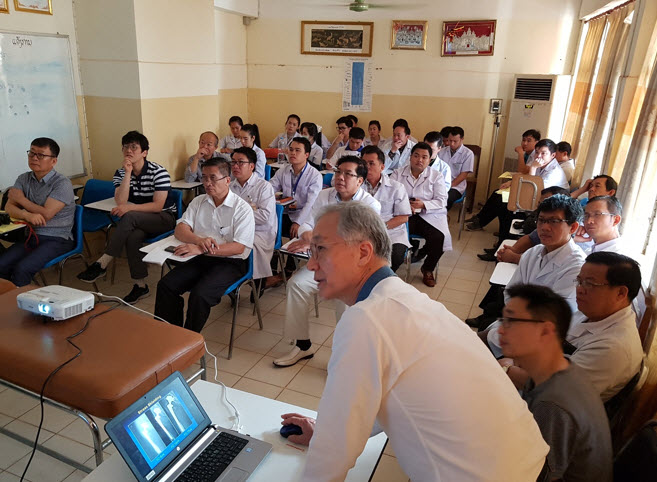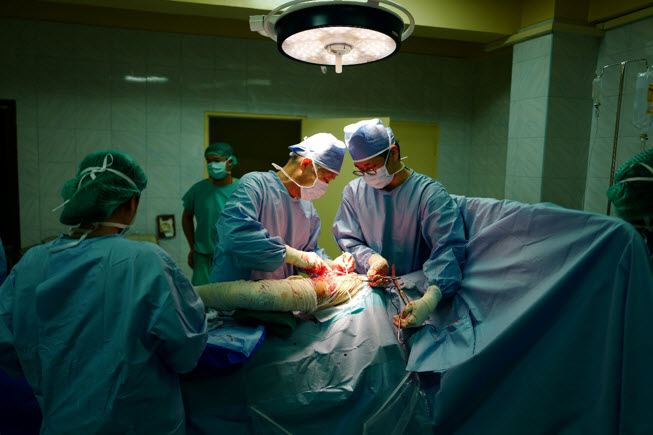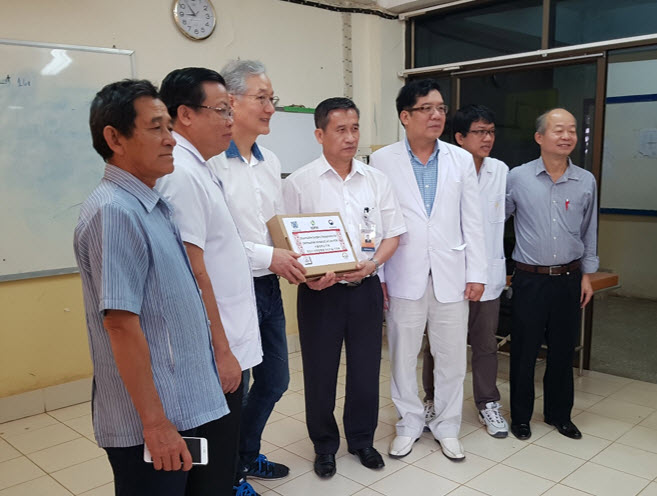
Dr. Kim In Kwon gives a lecture on joint surgery to Laotian doctors.
It’s February 14, 2018 at a hospital in Vientiane, Laos. Dr. Kim In Kwon, Director Emeritus of the Yeosu Ae-Yang Hospital in Korea, leads a surgical procedure in a small operating room with only a single surgical bed, a surgical light and a heart rate monitor. The patient is 87-year-old Bun-Ma, who had previously undergone a hip replacement surgery from a local physician. Due to improper surgical practices, however, the joint was never properly attached.
Following removal of the artificial joint, Dr. Kim and his medical staff cap the bone to secure it in place. Though this procedure can often take up to three or four hours, Dr. Kim's team skillfully finish in 30 minutes. Over the span of four days, the team carried out 23 free surgical services like this one. Many Lao patients—like 19-year-old Tanosak, who could not walk properly due to a severe case of rheumatoid arthritis—were able to receive free surgical care from the Korean staff.
However, the efforts of Dr. Kim and his team did not stop at curing patients. Khambanh Ban Salishi, an orthopedic surgeon at the Mittaphab Hospital, closely observed and worked alongside Kim’s team throughout the surgery. Dr. Ban Salishi was one of the medical practitioners selected for the Dr. Lee Jong-wook Seoul Project, which aims to share Korean medical technology with Lao medical staff. Ban Salishi explained that the operation was the first time he participated in a hip surgery, “Through opportunities like this, I’ll eventually be able to lead my own operations for Lao patients.”

Dr. Kim In Kwon is performing a hip surgery and the Laotian doctors participated as learners.
The Seoul Project was launched in 2010 by the SNU College of Medicine and is funded by the Korea International Health Care Foundation. Named after Dr. Lee Jong-wook, SNU College of Medicine alumnus and former Director-General of the World Health Organization, the project selects about ten Lao medical practitioners each year to train at hospitals such as the SNU Hospital and Yeosu Ae-Yang Hospital.
The project aims to carry on the legacy of the U.S.-funded Minnesota Project. Following the Korean War (1950-1953), the U.S. government launched the Minnesota Project to assist Korea in engineering, medicine, agriculture, and public administration sectors. To help build Korea’s medical infrastructure, more than 70 young SNU doctors were trained at the University of Minnesota, while a number of medical experts from different fields at the University of Minnesota were sent to SNU to lead medical initiatives.
Kwon E-hyock, former Seoul National University President and Minister of Health and Social Affairs, and Ho Wang Lee, who discovered the Hantann Virus, the leading cause of epidemic hemorrhagic fever, were two of many participants of the Minnesota Project that helped to advance medical care and health care standards in Korea.
Participants of the Dr. Lee Jong-wook Seoul Project, which includes around 60 Lao medical practitioners, are leading efforts to improve medical standards in Laos. Gynecologist Pim Mason Sirimanotom, who in 2011 was trained by Professor Park Jung Shin of the SNU Department of Obstetrics and Gynecology, is currently the leading expert in pregnancy ultrasound analysis in Laos. Will Lafenpai Mani, who received training in pediatric intensive care unit management technology from Professor Park Joon-dong of the SNU Department of Pediatrics in 2016, is currently operating the intensive care unit of the only children’s hospital in Laos. Lafenpai Mani stated, "During my time in Korea, I was able to learn many advanced techniques in intubation and central venous catheter insertion.”
Shin Hee Young, Chairman of the Dr. Lee Jong-wook Seoul Project and SNU Vice President for Research and Development highlighted the project’s mission in Laos: “By treating patients who would otherwise have not been cured and assisting in the modernization of medicine, we hope to help the nation’s healthcare industry stand on its own two feet.”

SNU donated the surgical instruments to Mittaphab Hospital after the project
Source: http://news.chosun.com/site/data/html_dir/2018/03/20/2018032000373.html
Written by Frances Seowon Jin, SNU English Editor, seowonjin@snu.ac.kr
Reviewed by Professor Travis Smith, Department of Asian Languages and Civilizations, tlsmith@snu.ac.kr

